In today’s fast-growing digital landscape, SaaS enterprise solutions have become a cornerstone of business operations. However, as your organization increasingly relies on cloud-based services, ensuring robust security measures for SaaS applications has never been more critical.
SaaS, or Software as a Service, refers to cloud-based applications that are hosted and managed by a third-party provider. Leveraging SaaS brings your company numerous advantages, such as scalability, cost-efficiency, and flexibility. Yet, it also necessitates a clear understanding of the shared responsibility model, where your SaaS provider is accountable for the underlying infrastructure’s security. At the same time, your organization retains responsibility for securing your data and user access.
Key Threats to SaaS Security
Data breaches and unauthorized access pose significant risks to SaaS enterprise solutions. Insider threats and privileged user abuse can also compromise data integrity. Weaknesses in APIs and integrations, inadequate data encryption, and improper access controls further exacerbate vulnerabilities. Compliance and regulatory concerns must be addressed to avoid legal and reputational ramifications.
Best Practices for SaaS Security
Vendor Selection and Due Diligence
When choosing a SaaS provider, you should evaluate the vendor’s security measures, reputation, and compliance certifications. Due diligence is crucial to ensuring that the provider aligns with the organization’s security requirements and can effectively protect sensitive data.
Get their authorization to obtain Service Organization Control (SOC) reports through third-party auditors. These reports offer an independent assessment of the SaaS provider’s internal controls related to security, availability, confidentiality, and privacy.
Data Protection and Encryption
Encrypting sensitive data at rest and in transit is paramount. Implementing strong access controls, authentication mechanisms, regular data backups, and rigorous testing of restore procedures helps fortify data protection.
Data loss prevention (DLP) solutions can provide an additional layer of security. Drawing up a successful DLP plan requires you to organize, prioritize, locate, and establish ownership of your organization’s data.
User Access and Authentication
Implementing multi-factor authentication (MFA) adds an extra level of defense against unauthorized access. Given the prevalence of BYOD policies, the surge in data breaches, security compromises, phishing, fraud, and identity theft, and the consequent establishment of government regulations, the demand for MFA is on the rise. Enforcing strong password policies and regularly reviewing user access privileges helps your company mitigate the risk of compromised accounts. User activity monitoring enables prompt detection and response to suspicious activities.
API Security and Integration
Even robustly API-secured platforms are vulnerable to bad actors and security breaches, so the risk to unprotected platforms is unimaginable. Validating and securing API endpoints is vital to preventing potential breaches. Implementing rate limiting and throttling mechanisms helps protect against malicious activities and ensure API performance. Regular security audits of integrations and continuous monitoring of API activity can identify and address vulnerabilities.
Incident Response and Recovery
Developing a well-defined incident response plan is crucial to minimizing the impact of security incidents like Ransomware and DDoS. Establishing communication channels and escalation procedures enables swift action. Frequent testing of incident response plans and learning from previous incidents allows your organization to refine and improve its security processes. A company with a dedicated incident response team will ensure that the financial losses associated with a data breach are considerably lower than those of its counterpart without one.
Compliance and Regulatory Considerations
Your organization must understand industry-specific compliance requirements and ensure that its SaaS enterprise solutions adhere to these standards. You should prioritize data privacy and protection to safeguard sensitive information. Regular audits and assessments help maintain compliance, and collaboration with legal and compliance teams ensures comprehensive coverage.
Compliance with ISO/IEC 27001 and the General Data Protection Regulation (for European Union Citizens), the international standards for information security management systems, ensures the provider has implemented stringent security controls, risk management procedures, and ongoing monitoring to protect your data.
Continuous Monitoring and Improvement
Implementing robust security monitoring tools and solutions provides real-time visibility into SaaS environments. Vulnerability assessments, network configurations, malware protection tools, and penetration testing help identify and address potential weaknesses. Staying updated with security patches and updates is crucial to safeguarding against emerging threats. Ongoing security awareness training for your employees helps create a security-conscious culture.
Conclusion
SaaS enterprise solutions offer unparalleled convenience and scalability, but security must remain at the forefront. By understanding the shared responsibility model and implementing best practices, your organization can confidently protect its data in the cloud. Prioritizing vendor selection, user access controls, API security, compliance considerations, and continuous monitoring ensures a robust SaaS security posture. STL Digital can help you implement these practices to fortify your company’s security and preserve the integrity of your valuable data.
FAQs
- How can SaaS security enhance the efficiency of business operations?
SaaS enterprise solutions offer a range of benefits, including streamlined data management, automated backups, and real-time threat monitoring. By leveraging robust security measures, businesses can focus on their core activities with peace of mind, knowing that their data is safe. This makes the teams more productive and agile, ultimately driving business growth and success.
- Can SaaS security solutions help scale the business more effectively?
Yes, SaaS security solutions are designed to accommodate business growth. With cloud-based scalability, businesses can easily adapt their security infrastructure to meet the changing needs of their organization. Whether expanding their team or entering new markets, SaaS security solutions provide the flexibility and agility required to scale business seamlessly.
- How can SaaS security solutions improve collaboration and data sharing within an organization?
SaaS security solutions enable secure collaboration and data sharing among employees, departments, and even external stakeholders. With granular access controls and encryption, organizations can confidently share sensitive information while maintaining data integrity. Enhanced collaboration tools within SaaS solutions facilitate seamless communication, boosting teamwork and productivity across an organization.
- Will implementing SaaS security solutions save an organization time and resources?
Absolutely. SaaS security solutions streamline security operations, eliminating the need for costly infrastructure investments and dedicated security teams. By leveraging their expertise and infrastructure, organizations can redirect valuable resources to other strategic initiatives. With automated security updates and maintenance, they’ll save time and effort, allowing them to focus on core business objectives.
- Can SaaS security solutions improve a company’s compliance and data posture?
Yes, SaaS security solutions align with industry-specific compliance standards and data privacy regulations. By partnering with a reputable SaaS provider, companies can gain access to a secure and compliant infrastructure. They handle the implementation of security controls and conduct frequent audits, ensuring the company meets regulatory requirements. This helps build trust with customers, enhances brand reputation, and minimizes the risk of legal and financial consequences.



